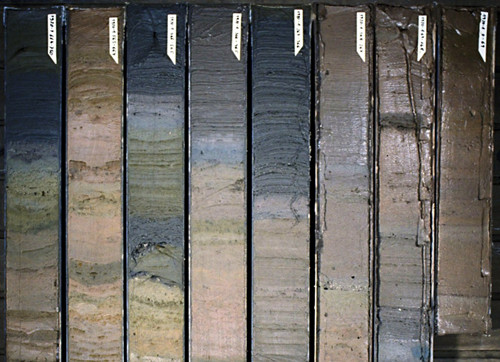Environmental archaeology shows relationship of humans, nature
Author : Wu Nan Source : Chinese Social Sciences Today 2016-07-14

The study of lake sediment, a typical example of environmental archaeology, reveals the ways in which humans and the environment interact with each other.
Environmental archaeology is an emerging research area within the broader disciplines of archaeology and geoscience. It focuses on issues related to climate that occurred after the Holocene Age, which started about 11,700 years ago. This research helps to unravel the relationship between humans and the environment since the Neolithic Age.
Reflection
“With the end of the Ice Age, the global climate and environment improved a lot, providing favorable conditions for human survival and evolution. Human history entered a period of accelerated development,” said Shui Tao, a professor of history at Nanjing University. He pointed out that improved living conditions brought about a boom in the population while changing the division of labor and complexity of societies. Civilizations and countries emerged due to this process and they produced complicated social structures in modern times. Therefore, all those changes in humanity were shaped by the environment and climate. In this sense, environmental archaeology is indispensable because it reveals general laws governing the evolution of human society.
Using his study of lake sediment as an example, Li Shijie, a research fellow from the Institute of Geochemistry at the Chinese Academy of Sciences (CAS), argued that humans and the environment affect each other and the evidence of this can be seen in changes to the earth’s surface.
Cooperation
In the past, archaeological research focused on the cultural legacy of human beings, while environmental studies paid more attention to nature. There was not much cooperation between the two research fields. But now, archaeologists also investigate environmental changes during excavations. They often invite environmental experts to participate in fieldwork and extract specimens related to environmental factors for quantitative analysis. Thus, the archaeologists and environmentalists established a research mechanism for cooperation. In this way, research results can be more accurate and reliable.
Chen Fahu, a professor from Lanzhou University and academician of the CAS, explained the whole process of how humans migrated to the Qinghai-Tibet Plateau in prehistoric times. He said that the process had four stages. Early human activities first occurred on the plateau 8,000 years ago. Around 8,000 to 6,000 years ago, the activities of hunter-gatherers became more frequent due to the extrusion of millet-based agriculture on the Loess Plateau. The third stage began 6,000 to 4,000 years ago, when agriculture spread to low-altitude areas of the plateau. The earliest wheat-based agriculture appeared on the Hexi corridor, while the hunter-gatherers lifestyle remained on the plateau hinterland. Finally, 4,000 to 2,300 years ago, wheat-based agriculture became common around the Qinghai-Tibet plateau.
The research offered explanations for human migration to high-altitude localities, solving a major theoretical issue in archaeological studies. Xia Zhengkai, a professor from Peking University, adopted a similar research perspective when investigating environmental changes that took place in the ancient cities in arid parts of Central Asia. In his research, Xia indicates that those cities rose and fell due to the changes in the lakes of the area.
Xia said that in those regions where rainfall is scarce, cities were built near a water source. As the source became exhausted, cities were abandoned. Many ancient cities in Central Asia shared this fate. Shui pointed out that archaeologists tend to concentrate on social changes and the development of ancient cities, neglecting such problems as water sources. Xia’s research is a typical example of how environmental archaeology can facilitate research on the evolution of human history. It can uncover the rules governing the evolution of ancient cities.
Future research
Future research on environmental archaeology must strengthen interdisciplinary studies and application of long-term models. Monographic studies on the origin of human beings, the origin and spread of agriculture, land utilization, and exploration of natural resources are expected. Integrating science and social science to investigate the dynamic relations between humans and the earth should be emphasized, Xia said.
“Scholars engaged in environmental archaeology come from different fields such as geography, geology, biology and archeology. They adopt research methods from different disciplines and focus on the relationships between human beings and the environment,” Xia said. Now there is much to be investigated in environmental archaeology. At the present stage, the research focus is often on the analysis of the site, especially big sites.
Shui pointed out that research in environmental archaeology requires interdisciplinary efforts because the objects of study are relatively diverse. Environmental archaeologists should broaden and deepen their research areas and cooperate with other experts, which will contribute to the overall development of the discipline, Shui said.
Ye Shengtao made Chinese fairy tales from a wilderness
Ye Shengtao (1894–1988) created the first collection of fairy tales in the history of Chinese children’s literature...
-
How northern ethnicities integrated into Chinese nation
2023-09-18
-
Mogao caves
2023-09-12
-
Mogao Grottoes as ‘a place of pilgrimage’
2023-09-12
-
Time-honored architectural traditions in China
2023-08-29
-
Disentangling the civilizational evolution of China
2023-08-28
-
AI ethics in science fiction
2023-08-23














 2011-2013 by www.cssn.cn. All Rights Reserved
2011-2013 by www.cssn.cn. All Rights Reserved